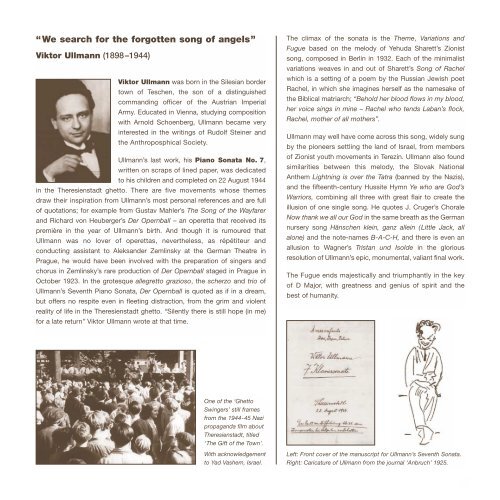Paul Crossley A5 flyer Final - Viktor Ullmann Foundation
Paul Crossley A5 flyer Final - Viktor Ullmann Foundation
Paul Crossley A5 flyer Final - Viktor Ullmann Foundation
You also want an ePaper? Increase the reach of your titles
YUMPU automatically turns print PDFs into web optimized ePapers that Google loves.
“We search for the forgotten song of angels”<br />
<strong>Viktor</strong> <strong>Ullmann</strong> (1898–1944)<br />
<strong>Viktor</strong> <strong>Ullmann</strong> was born in the Silesian border<br />
town of Teschen, the son of a distinguished<br />
commanding officer of the Austrian Imperial<br />
Army. Educated in Vienna, studying composition<br />
with Arnold Schoenberg, <strong>Ullmann</strong> became very<br />
interested in the writings of Rudolf Steiner and<br />
the Anthroposphical Society.<br />
<strong>Ullmann</strong>’s last work, his Piano Sonata No. 7,<br />
written on scraps of lined paper, was dedicated<br />
to his children and completed on 22 August 1944<br />
in the Theresienstadt ghetto. There are five movements whose themes<br />
draw their inspiration from <strong>Ullmann</strong>’s most personal references and are full<br />
of quotations; for example from Gustav Mahler’s The Song of the Wayfarer<br />
and Richard von Heuberger’s Der Opernball – an operetta that received its<br />
première in the year of <strong>Ullmann</strong>’s birth. And though it is rumoured that<br />
<strong>Ullmann</strong> was no lover of operettas, nevertheless, as répétiteur and<br />
conducting assistant to Aleksander Zemlinsky at the German Theatre in<br />
Prague, he would have been involved with the preparation of singers and<br />
chorus in Zemlinsky’s rare production of Der Opernball staged in Prague in<br />
October 1923. In the grotesque allegretto grazioso, the scherzo and trio of<br />
<strong>Ullmann</strong>’s Seventh Piano Sonata, Der Opernball is quoted as if in a dream,<br />
but offers no respite even in fleeting distraction, from the grim and violent<br />
reality of life in the Theresienstadt ghetto. “Silently there is still hope (in me)<br />
for a late return” <strong>Viktor</strong> <strong>Ullmann</strong> wrote at that time.<br />
One of the ‘Ghetto<br />
Swingers’ still frames<br />
from the 1944-45 Nazi<br />
propaganda film about<br />
Theresienstadt, titled<br />
‘The Gift of the Town’.<br />
With acknowledgement<br />
to Yad Vashem, Israel.<br />
The climax of the sonata is the Theme, Variations and<br />
Fugue based on the melody of Yehuda Sharett’s Zionist<br />
song, composed in Berlin in 1932. Each of the minimalist<br />
variations weaves in and out of Sharett’s Song of Rachel<br />
which is a setting of a poem by the Russian Jewish poet<br />
Rachel, in which she imagines herself as the namesake of<br />
the Biblical matriarch; “Behold her blood flows in my blood,<br />
her voice sings in mine – Rachel who tends Laban’s flock,<br />
Rachel, mother of all mothers”.<br />
<strong>Ullmann</strong> may well have come across this song, widely sung<br />
by the pioneers settling the land of Israel, from members<br />
of Zionist youth movements in Terezin. <strong>Ullmann</strong> also found<br />
similarities between this melody, the Slovak National<br />
Anthem Lightning is over the Tatra (banned by the Nazis),<br />
and the fifteenth-century Hussite Hymn Ye who are God’s<br />
Warriors, combining all three with great flair to create the<br />
illusion of one single song. He quotes J. Cruger’s Chorale<br />
Now thank we all our God in the same breath as the German<br />
nursery song Hänschen klein, ganz allein (Little Jack, all<br />
alone) and the note-names B-A-C-H, and there is even an<br />
allusion to Wagner’s Tristan und Isolde in the glorious<br />
resolution of <strong>Ullmann</strong>’s epic, monumental, valiant final work.<br />
The Fugue ends majestically and triumphantly in the key<br />
of D Major, with greatness and genius of spirit and the<br />
best of humanity.<br />
Left: Front cover of the manuscript for <strong>Ullmann</strong>’s Seventh Sonata.<br />
Right: Caricature of <strong>Ullmann</strong> from the journal ‘Anbruch’ 1925.<br />
5


